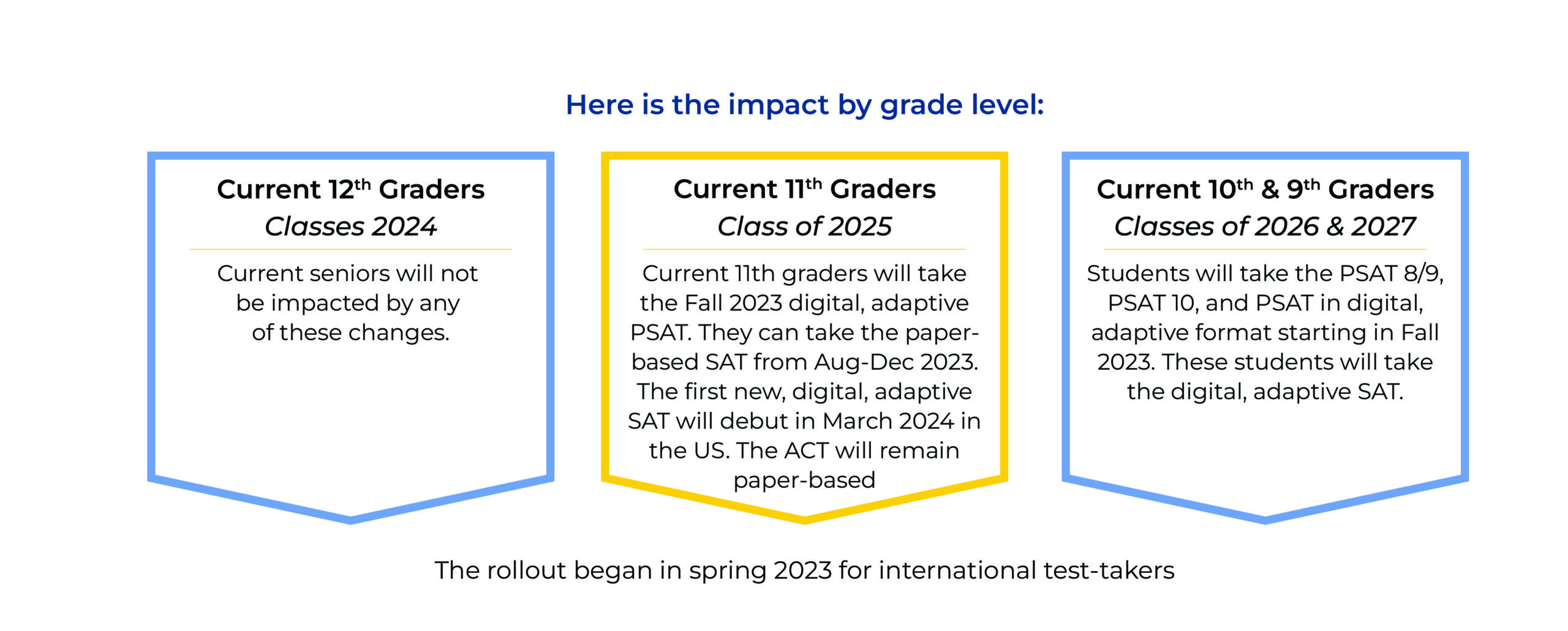It’s about to be a brave new world for SAT takers – and we’re here to make sure you are ready for it! U.S. juniors (Class of 2025) were the first to take the October PSAT in digital form this fall and then (drum roll, please) the brand new, shorter, digital adaptive SAT debuting in March 2024.
International students first experienced the new, digital, adaptive SAT in March of 2023.

THE NEW SAT AT A GLANCE
So, What’s Staying the Same?
- Scaled Score Ranges: Students will still receive a scaled score between 200-800 for each section, with the total scaled score ranging from 400-1600.
- Test Locations: Students will still test in school settings or official testing centers with proctors and their peers.
- Overall Sections: Students will still complete two Reading & Writing sections and two Math sections, now called modules.
- Content: Much of the Math and Grammar content will be comparable to the current test.
What’s Changing?
- Test Format & Timing: A huge positive of the digital SAT is that the total testing time has been cut by nearly ⅓! Like its predecessor, the digital SAT will have two sections – Reading and Writing, and Math. This time, however, each section will be broken down into two individual, “stage adaptive” modules.
Test Timing Breakdown
| New Digital Adaptive SAT | |
| Total Time | 2 hours & 14 minutes, plus one break (10 minutes) |
| Total Questions | 98 questions |
| Math (2 modules) | 70 minutes, 44 questions |
| Reading & Writing (2 modules) | 64 minutes, 54 questions |
| Time per Question | 95 seconds for Math
71 seconds for Reading and Writing |
- Adaptive Testing: You need to start strong! The digital SAT will be stage adaptive, meaning the level of difficulty of the questions a student receives in the second module of each section will be based on the student’s performance in the first module. The second module a student receives will impact their scoring potential.
- Scoring Potential: There are two options for a student’s second module. There is a fixed scaled score range depending on the level of difficulty in that module.
- If a student receives the easier second Reading and Writing or Math module, their fixed scaled score range is ~200-600.
- If a student receives the harder second Reading and Writing or Math module, their fixed scaled score range is ~450-800.
- The more difficult questions carry more weight in the scaled score, NOT the number of questions correct.
- Each Test is Unique: The QAS will no longer be available and students will not be able to access their test questions after the exam because there will be no single standardized test form. However, the digital element of the new SAT allows students to receive their scores much quicker – within days instead of weeks.
THE NEW MATH SECTION
Rest assured! The concepts found in the new Math section are very similar to those on the paper-based SAT.
- All Calculator: A Big Win for Students! Students will now be able to use a calculator on both modules in the Math section. The College Board has embedded a Desmos calculator into their testing platform for convenient, on-screen use; alternatively, a student may still choose to use an approved, handheld device. Students can practice via the Desmos website.
- A Focus on Math in the Math Section: The College Board has made key shifts to the question formats in the Math section to focus more on testing a student’s math skills and less on testing a student’s literacy skills.
There will be an increase in geometry and trigonometry questions – roughly 8% of the current SAT, moving to 15% of the digital test – and a decrease in lengthy word problems, probability, statistics, and data analysis.
Math Content Breakdown
| New Digital Adaptive SAT | |
| Algebra | 35% |
| Advanced Math | 35% |
| Problem Solving & Data Analysis | 15% |
| Geometry & Trigonometry | 15% |
THE NEW READING AND WRITING SECTION
Great news! The dreaded historical and paired passages are no more!
- Two Modules, Shorter Passages, Streamlined Approach: The test will no longer be divided between a stand-alone “Reading” section and “Writing and Language” section. Instead, it will consist of two modules that will each include a mix of reading and writing questions. The readings on the digital SAT will be shorter, with one question assigned to each passage.
Additional, noteworthy changes include the following:
- more humanities passages
- more logical transition questions
- additional focus on vocabulary, specifically words in context
- a decrease in the emphasis on grammar
- each passage will present a new topic, voice, and style
- the level of difficulty increases from question to question within a question type group
Reading and Writing Content Breakdown: Topics
| New Digital Adaptive SAT | |
| Information & Ideas | ~26% |
| Craft & Structure | ~28% |
| Expression of Ideas | ~20% |
| Standard English Conventions | ~26% |
| Rhetoric | N/A |
| Synthesis | N/A |
WHAT’S NEXT FOR YOU?
In this evolving landscape, it’s even more important for students to choose the test and the timeline that best fits their needs. Some may prefer the known, paper-based ACT, while others may opt for the new, digital adaptive SAT in spring 2024. We are here to help you make the right choice! Our teachers and tutors are excited for the digital SAT and eager to help students reach their optimal score.


